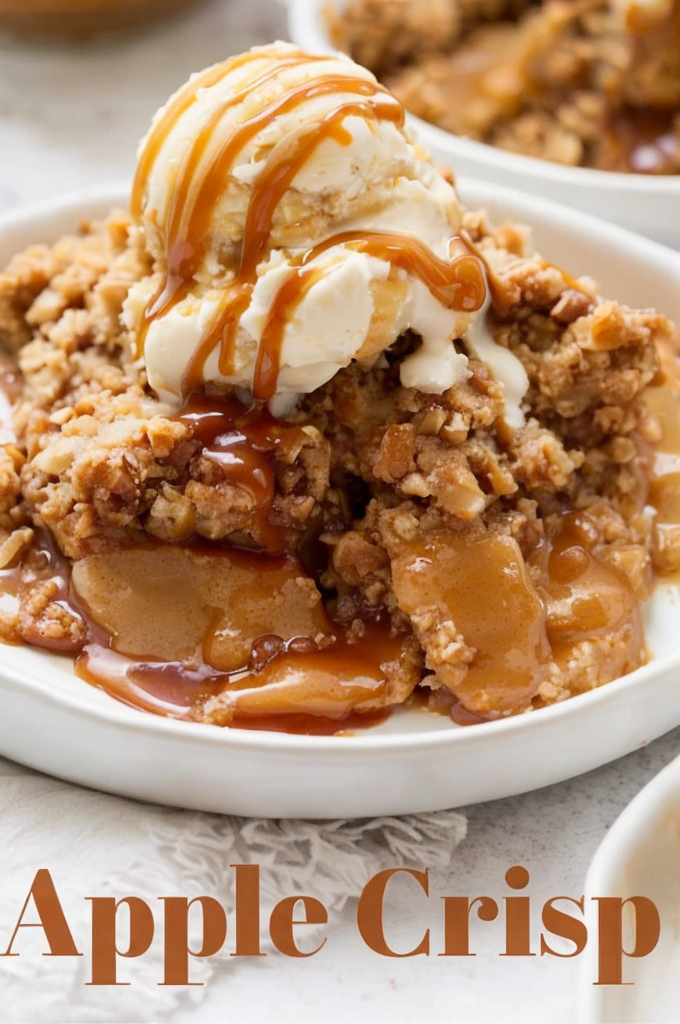Easy Salted Caramel Apple Crisp – Family Favorite Recipe
Easy Salted Caramel Apple Crisp – The Ultimate Family Favorite Dessert
There’s nothing quite like the comforting aroma of an Easy Salted Caramel Apple Crisp baking in the oven. This family favorite recipe melds the delightfully sweet and tart essence of apples with the rich, buttery notes of caramel and a hint of sea salt, creating a dessert that’s sure to please any crowd. With its crunchy oat topping and gooey apple center, this salted caramel apple crisp is both a visual and gustatory delight. Perfect for autumn gatherings or as a warm treat on a chilly evening, this apple crisp combines familiar flavors in an effortlessly impressive way.
Quick Recipe Highlights
- Flavor Profile: This dessert balances sweet and salty notes perfectly, with a hint of tartness from the apples and a buttery richness from the caramel.
- Texture: The crisp topping adds a satisfying crunch that contrasts beautifully with the soft, juicy apples below.
- Aroma: The mingling scent of cinnamon, caramel, and baked apples creates an inviting, cozy atmosphere in your home.
- Visual Appeal: A golden brown topping with caramelized edges makes this apple crisp as beautiful as it is delicious.
- Skill Level Needed: Any home baker, regardless of experience, can easily prepare this straightforward recipe.
- Special Equipment: A baking dish and a mixing bowl are all you need – no fancy equipment required!
Recipe Overview
- Difficulty Level: This recipe is rated as easy due to its simple ingredient list and straightforward preparation steps, making it perfect for beginner bakers and children.
- Category: This crisp fits squarely into the dessert category, although it could serve as a sweet finish to any meal.
- Cuisine: Rooted in classic American baking traditions, it draws from the time-honored tradition of apple desserts.
- Cost: Made with pantry staples and seasonal produce, this budget-friendly dessert won’t break the bank.
- Season: Best enjoyed during the fall, when apples are at their peak, but delightful year-round with available ingredients.
- Occasion: Ideal for family dinners, festive holiday gatherings, or simply as a cozy, comforting treat.
Why You’ll Love This Recipe
The combination of textures in this easy salted caramel apple crisp makes every bite a delightful experience. With juicy, tender apples and a crunchy, buttery topping, it’s a textural masterpiece. Caramel enhances the flavor profile with its deep, rich taste, while a hint of salt amplifies each element, creating a well-balanced dish that satisfies all taste buds.
The convenience of this recipe is another reason to love it. Made with everyday ingredients such as oats, butter, flour, and seasonal apples, it requires minimal shopping effort. Preparation is straightforward, with simple steps that don’t demand advanced kitchen skills or techniques. This makes it perfect for a last-minute dessert that will still impress.
Nutritionally, this apple crisp has benefits to offer. Apples provide fiber and vitamin C, while oats add wholesome grains to the dessert. When served in moderation, it can be a part of a balanced diet, making it an indulgence with even a glimmer of nutritional value.
Social and entertaining value should not be overlooked. Sharing a warm dish straight from the oven creates a sense of connection and nostalgia. The inviting smell alone can serve as a warm welcome to guests, making it ideal for entertaining friends and family.
Finally, this dessert is both cost-effective and accessible. Most of the ingredients are likely already in your pantry, and the fresh produce can be found at reasonable prices, especially during apple season. Its affordability doesn’t compromise its taste or quality, making it a practical choice for any occasion.
Historical Background and Cultural Significance
The apple crisp traces its origins back to the United States during the colonial era when similar baked desserts were a staple of American pioneer cooking. It evolved as an economical alternative to more elaborate pastries and pies, utilizing simpler ingredients that were easily accessible to settlers.
Culturally, the apple crisp has come to embody the essence of comforting home-cooked meals. It reflects the agricultural heritage of America, where apples became one of the earliest and most abundant fruits cultivated, particularly in New England and the Midwest regions.
The recipe has evolved over time, incorporating the luscious addition of caramel in recent decades, likely influenced by contemporary culinary trends emphasizing salted caramel. This adaptation has been embraced enthusiastically, adding a sophisticated twist to the beloved classic.
Regionally, variations on the apple crisp can be found around the world, where local fruits replace apples, or where spices and nuts are added to reflect regional tastes. What remains consistent is the combination of a fruit base with a crisp, buttery topping, making it adaptable and universally loved.
Ingredient Deep Dive
Apples are the soul of this recipe. Known as one of America’s favorite fruits, the apple’s history stretches back thousands of years to their origins in Central Asia. Nutritionally, they’re rich in vitamins A and C, with dietary fiber that aids digestion. When selecting apples for this recipe, go for firm, tart varieties such as Granny Smiths or McIntosh for a balanced flavor. Store them in a cool, dry place or refrigerate to extend their shelf life. If you can’t find the right variety, pears or peaches can be a good substitute.
Oats lend their hearty texture to the crisp topping. Historically, oats have been a staple crop in many cultures, valued for their nutritional benefits, including high fiber and good carbohydrates. Opt for old-fashioned or rolled oats to maintain texture; quick oats can become too mushy. Store oats in an airtight container in a cool, dry place to keep them fresh. If you’re gluten-sensitive, choose certified gluten-free oats.
Common Mistakes to Avoid
- Choosing incorrect apple varieties: Avoid overly sweet or soft apples, as they can make the crisp too mushy.
- Using warm butter: Always use cold butter for the topping to achieve a crumbly texture, not a greasy one.
- Over-mixing the topping: Mix until the ingredients are just combined to preserve texture.
- Not preheating the oven: Ensure the oven is fully preheated to achieve consistent cooking.
- Skipping the salt: Don’t underestimate the salt; it enhances and balances the flavors.
- Underbaking: Make sure the topping is golden brown; underbaking leaves it soggy.
- Storing improperly: Use an airtight container to retain freshness when storing.
- Ignoring substitutions: Be mindful of the impact subbing ingredients like butter or oats can have on flavor and texture.
- Caramel shortcuts: Use high-quality caramel instead of sauces with additives that can alter taste.
- Neglecting temperature: Serve either warm or at room temperature for the best flavor experience.
Essential Techniques
Making a successful crisp involves understanding the topping technique. Achieving the perfect texture requires using cold, cubed butter combined with flour, sugar, and oats. The process of cutting the butter into the dry ingredients ensures a crumbly texture that’s not too dense.
The second key technique is managing the apple filling. Apples need to be evenly sliced to cook uniformly. A combination of sugar, flour, and a splash of lemon juice will coat the apples, drawing out natural sweetness and ensuring they’re tender but not mushy.
Pro Tips for Perfect Easy Salted Caramel Apple Crisp
Use a mix of tart and sweet apple varieties for the best flavor. This balance brings depth and complexity to the dish that a single variety cannot.
Always chill your topping mixture before sprinkling it over the apple filling. This step helps in achieving a perfect, crumbly texture.
Add a very light dusting of cinnamon and nutmeg to the topping. It’s subtle but adds warmth and enhances the dish’s aroma.
Drizzle homemade salted caramel sauce for the boldest flavor impact. The process may be simple, but the taste is unbeatable when fresh caramel is used.
Consider toasting the oats slightly before mixing to enhance their nutty flavor. This extra step takes only minutes and yields a tastier topping.
If the apples are particularly juicy, add an extra tablespoon of flour to the filling to thicken the mixture and prevent it from being watery.
Variations and Adaptations
For regional variations, try incorporating local fruits like peaches or mixed berries to marry with the apples in your crisp, creating a delightful fusion of flavors.
During different seasons, consider integrating spices such as clove or cardamom to complement fall’s apple harvest or refreshing lemon zest in spring.
For dietary modifications, you can make this dish gluten-free by using almond flour in the topping and ensure that your oats are also certified gluten-free.
Experiment with flavor variations by adding fresh ginger for a zingy twist or chopped nuts to the topping for a protein-rich addition.
If aiming for a different texture, incorporate desiccated coconut into the topping for a tropical sweetness that meshes well with caramel.
Presentation can be modernized by baking individual servings in ramekins for an elegant finish, making it easy to serve and appealing to guests.
Serving and Presentation Guide
When serving your easy salted caramel apple crisp, consider dish aesthetics. A crisp white plate or ramekin allows the golden topping to stand out. For garnish, a simple dollop of vanilla ice cream or whipped cream with a light caramel drizzle makes the dish pop.
Traditional accompaniments for apple crisps include a scoop of vanilla ice cream, which complements the warm dessert, but feel free to explore with flavored yogurt or a custard pour-over for a luxurious twist.
In terms of modern serving, small individual portions cater to more intimate gatherings, neatly plated in ramekins for a polished presentation.
Temperature considerations are vital; serve warm, allowing the caramel to be perfectly gooey and the flavors to meld beautifully. However, it’s equally satisfying at room temperature.
To manage portion control, consider slicing and serving in smaller pieces first, allowing guests to gauge their portion preferences, which is particularly helpful in group settings.
Wine and Beverage Pairing
Pairing wine with your dessert involves choosing options that complement its flavor profile. A late harvest Riesling carries the crisp sweetness that echoes the caramel apple’s essence, enhancing the dish without overpowering it.
For those preferring non-alcoholic alternatives, a spiced apple cider serves as a fantastic companion. The familiar apple taste coupled with spices mirrors the dessert’s own flavors.
If coffee is your preference, consider a light roast with fruity notes that emphasizes the dessert’s fresh, bright flavors. Alternatively, a spicy chai tea also contrasts and complements the apple crisp beautifully.
Serving temperature for beverages is crucial; ensure wines are slightly chilled, while hot beverages are served warm, harmonizing with the dessert’s cozy nature.
Suggestions for delightful serving: keep beverages in a separate area from the food to prevent accidental mismatches, allowing guests the elegance of choice and exploration in pairing.
Storage and Shelf Life
For optimal storage, keep your apple crisp in an airtight container, storing it in the fridge to retain freshness. When properly sealed, it should last up to three days without much loss in quality.
Temperature plays a key role; avoid leaving your crisp at room temperature for extended periods. This helps prevent sogginess.
Choose a glass or ceramic container that fits the crisp without leaving too much air space. This prevents excess moisture from compromising the topping’s crunch.
Signs of spoilage include an overly soft filling or discolored topping. Be cautious of off-smells, indicating it’s past peak freshness.
To reheat, place your apple crisp in a low oven to gradually warm through, reviving the caramel and enriching the flavor without drying it out. A microwave can be used for faster reheats, though the topping may lose some crispness.
If you intend to freeze the crisp, do so before baking. Cover tightly, and it can last for up to one month. When ready to enjoy, bake directly from frozen, adjusting baking time as needed.
Make Ahead Strategies
For those looking to make ahead of time, prepare the filling and topping separately and store them in the refrigerator overnight for a quick baking session the next day.
Maintain quality by keeping the apples submerged in a light lemon water solution to prevent browning during storage. Assemble and bake just before serving to ensure the crisp topping stays light and crunchy.
During preparation, focus on dividing the crisp into manageable sections—slicing apples, preparing caramel, and constructing the topping—to streamline tasks.
Flavor continues to develop with time, so prepare components in advance without a significant compromise on taste. It’s about scheduling steps efficiently for time savings on busy days.
Consider reheating instructions that preserve the best possible texture, suggesting a low, slow heat for evenly returning the dessert to its flavorful peak.
For maximum freshness after preparation, add fresh garnishes like mint leaves just before serving to heighten presentation without premature wilting.
Scaling Instructions
Halving the recipe is straightforward: Simply adjust the ingredient measurements accordingly, and use a smaller baking dish to maintain thickness and cooking times.
Doubling or tripling requires ensuring your oven space can accommodate the dishes without overcrowding, which can impact cooking times. Consider using multiple racks and rotating dishes for even baking.
When altering quantities, remember to adjust spices and flavorings carefully. Overly strong flavors can easily dominate when multiplied.
Timing modifications may be necessary when scaling up, especially if larger or multiple dishes are used. Monitor closely towards the end of baking to avoid under or overcooking.
For larger gatherings, store the crisp in multiple smaller containers for easy serving and management, maintaining freshness and accessibility.
Be mindful that cooking larger batches might need extra stirring or heat redistribution if using additional layers or depth, protecting from inconsistency.
Nutritional Deep Dive
The macro breakdown of this dessert shows the balance of carbohydrates from the apples and oats, fats from the butter, and sugars primarily from the caramel.
Micronutrients come favorably from the apples, providing essential vitamins like C and A, along with fiber that aids digestion and satiety.
Attention to health benefits includes the dietary fiber from oats contributing to heart health and lowering cholesterol. Always enjoy in moderation, as part of a balanced diet.
Dietary considerations encompass typical allergens present, such as gluten in oats and flour or lactose in caramel and butter, with alternative options available for needs.
Portion analysis considers serving sizes; standard is generous while allowing for dietary modifications per preference or nutritional goals.
Weight management tips imply enjoying this dessert sparingly, savoring its flavors and pairing with complementary, lighter foods to keep balanced nutrition.
Dietary Adaptations
For a gluten-free version, substitute regular flour with gluten-free alternatives such as almond or rice flour. Ensure oats are certified gluten-free for added reassurance.
Dairy-free adaptations involve using plant-based butter alternatives and coconut cream for a luscious superfood twist without compromising taste.
A vegan-friendly crisp can be made by replacing dairy ingredients with coconut oil and maple syrup for a touch of natural sweetness.
For a low-carb or keto adaptation, reduce sugar given in the recipe and opt for low-sugar caramel substitutes, while emphasizing cinnamon for depth.
Paleo enthusiasts may substitute sugars with honey or coconut sugar and choose nut-based flours to adhere to dietary principles.
For a low-FODMAP solution, select specific apple varieties like cantaloupe or raspberry to replace higher FODMAP fruits.
The Recipe
Easy Salted Caramel Apple Crisp
Serves: 6
Prep Time: 20 mins
Cook Time: 40 mins
Total Time: 60 mins
Kitchen Equipment Needed
- Baking dish (9×9 inch)
- Mixing bowl
- Whisk
- Spatula
- Peeler and corer
Ingredients
- 6 medium apples, peeled, cored, and sliced
- 1/2 cup salted caramel sauce
- 2 tablespoons all-purpose flour
- 1 teaspoon ground cinnamon
- 1 cup old-fashioned oats
- 1/2 cup all-purpose flour
- 1/2 cup brown sugar
- 1/2 cup unsalted butter, chilled and cubed
- 1/4 teaspoon salt
Directions
- Preheat the oven to 350°F (175°C).
- In a large mixing bowl, combine apple slices, caramel sauce, flour, and cinnamon. Mix thoroughly to coat the apples evenly.
- Spread the apple mixture evenly into the baking dish.
- In another bowl, mix oats, flour, brown sugar, and salt. Cut in butter with a pastry cutter or fork until the mixture resembles coarse crumbs.
- Sprinkle the crumb topping evenly over the apples.
- Bake in preheated oven for 40 minutes or until the topping is golden brown and apples are tender.
- Let the crisp cool slightly before serving. Enjoy with a scoop of ice cream or a drizzle of additional caramel sauce.
Recipe Notes
- For best results, use a mix of apple varieties.
- If you prefer a sweeter topping, add an extra tablespoon of sugar.
- Store leftovers in the refrigerator for up to three days.
Troubleshooting Guide
For texture issues, always ensure your butter is chilled when making the topping, as melted butter leads to a less appealing final texture. Achieving the right balance in flavor, especially between sweetness and salt, requires tasting along the way, ensuring all ingredients are balanced.
Temperature problems often arise if the oven isn’t properly preheated or isn’t maintaining an even heat; use an oven thermometer for precision when in doubt. Equipment challenges can be minimized by using high-quality dishware that’s suitable for high-heat applications, minimizing sticking and leaking issues.
In situations where ingredients need substitutions, keep an eye on consistency and flavor profiles; using liquids instead of solids can inadvertently alter textures. Remember that timing concerns may require adjusting based on your equipment and personal preference for textures.
Recipe Success Stories
This delightful crisp has been a hit among our readers, who often share their own variations, such as adding berries or a touch more cinnamon to suit their taste. Community feedback often highlights the easy preparation steps, making it a go-to dessert for busy nights or last-minute gatherings.
Adaptation stories include using pears when apples aren’t available, which has been well-received for its unique and refreshing twist. Additionally, many have found success using coconut sugar or maple syrup as alternatives to regular sugar, sharing their sweet satisfaction in online groups.
Reader suggestions have added depth to the original recipe, with photography tips that capture the crisp’s golden perfection, making the dessert as visually pleasing as it is delicious.
Frequently Asked Questions
Can I use other fruits with the apple? Absolutely! Pears, peaches, and berries are excellent additions or substitutes in this crisp, bringing unique flavors while maintaining the dish’s essence.
What type of oats should I use? Use old-fashioned oats for best results. Quick oats may become too mushy, while steel-cut oats require longer cooking times.
How can I prevent my topping from being too dry? Ensure your butter is well-incorporated into the topping mixture and chill it before spreading over the apples to maintain a moist, crumbly texture.
Can I prepare this dish in advance? Yes, you can prepare the apple filling and topping separately up to a day ahead, storing them in the fridge and combining them just before baking.
How do I make the caramel sauce at home? Melt sugar in a pan until medium brown, add butter, then cream, and a dash of salt for homemade salted caramel sauce.
What’s a good substitute for caramel sauce? Honey or maple syrup can be good alternatives, though they will alter the flavor slightly from the classic caramel profile.
Why is my apple crisp soggy? If your crisp is soggy, it might be due to too much liquid from the apples; try adding a bit more flour to the filling to thicken it.
How can I make the topping crunchier? Consider sprinkling chopped nuts over the topping for an added crunch and a nutty flavor.
Do I need to peel the apples? It’s recommended for a smoother apple texture, but leaving the peel on can add fiber and a rustic aesthetic if desired.
How long can leftovers be stored? Store in an airtight container in the fridge for up to three days. Reheat in the oven for a fresher texture.
Can I freeze the apple crisp? Yes, freeze the dish before baking. When ready, bake from frozen, adjusting the cooking time as necessary.
What’s a good ice cream flavor pairing? Vanilla ice cream is classic, but cinnamon or butter pecan can add delightful complementary flavors.
Additional Resources
Explore related recipes like traditional apple pie or pear crumbles for inspiration and variation. Technique guides on making perfect pastry dough or creating homemade caramel can provide deeper insights into mastering this and similar recipes.
Ingredient information, such as the best apples for cooking or optimal caramel making tips, enhances understanding and results. For equipment recommendations, opt for high-quality, non-stick bakeware for consistency in baking.
Seasonal variations such as apple and cranberry crisp provide festive alternatives, allowing for exploration of tart and sweet combinations for different times of the year, ensuring your dessert repertoire stays exciting and versatile.
Join the Conversation
Engage on social media by sharing your own twists on the easy salted caramel apple crisp, inviting discussion on creative adaptations. Photography tips, such as capturing the crisp layers and caramel drizzle, contribute to visual storytelling.
Reviews and community feedback foster a shared appreciation, while recipe variations spark new ideas for those looking to adapt to personal tastes or dietary needs. Engage in these dialogues, learning from peers and contributing to the collective culinary experience.







